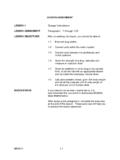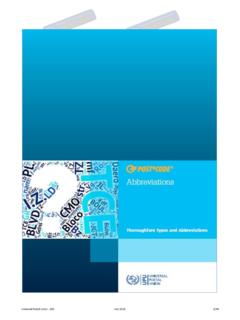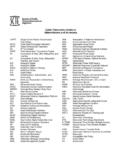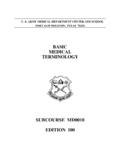Transcription of The Official TEACHER’S GUIDE AND for WHEELOCK’S LATIN
1 The OfficialTEACHER S GUIDE AND ANSWER KEYforWHEELOCK S LATIN6 Edition, RevisedthRichard A. LaFleurUniversity of Georgia[rev. 4-18-07: WATCH for changes in this revision date, as well asthe revision dates in the individual sections of the GUIDE , as existingmaterials are updated and new materials added periodically.] IMPORTANT NOTICE: If you are a studentcurrently enrolled in a LATIN class that assignsreadings and translations in wheelock for homeworkand/or credit and have somehow improperly gainedaccess to this key, be aware that such access isstrictly prohibited and very likely constitutes aviolation of your school s academic-honesty contents copyright, 2007, R. A. LaFleur-1-The Textbook s Evolution and ContentsWhen Professor Frederic wheelock 's LATIN first appeared in 1956, the reviews extolled itsthoroughness, organization, and concision; at least one reviewer predicted that the book "might wellbecome the standard text" for introducing college students and other adult learners to elementary , half a century later, that prediction has certainly been proven accurate.
2 A second edition waspublished in 1960, retitled LATIN : An Introductory Course Based on Ancient Authors and including a rich arrayof additional reading passages drawn directly from LATIN literature (the Loc Imm t~t ); the thirdedition, published in 1963, added Self-Tutorial Exercises, with an answer key, for each of the 40chapters and greatly enhanced the book's usefulness both for classroom students and for those wishingto study the language independently. In 1984, three years before the author's death, a list of passagecitations for the Sententiae Ant quae was added, so that teachers and students could more easily locateand explore the context of selections they found especially interesting; and in 1992 a fourth edition,titled wheelock s LATIN Grammar, appeared under the aegis of the book's new publisher, HarperCollins,in which the layout of the text was handsomely fifth edition, published in 1995 and aptly retitled wheelock 's LATIN , constituted the first trulysubstantive revision of the text in more than 30 years.
3 The revisions which I introduced were intended,not to alter the basic concept of the text, but to enhance it; indeed, a number of the most significantchanges were based on Professor wheelock 's own suggestions, contained in notes made available forthe project by his family, and others reflected the experiences of colleagues around the country, manyof whom (myself included) had long used and admired the book and had in the process arrived at someconsensus about certain basic ways in which it might be improved for a new generation of most obvious change in the fifth edition reflected wheelock 's own principal desideratum,shared by myself and doubtless by most who had used the book over the years, and that was theaddition of passages of continuous LATIN , based on ancient authors, to each of the 40 chapters.
4 Theseare in the early chapters quite brief and highly adapted, but later on are more extensive and oftenexcerpted verbatim from a variety of prose and verse authors; some had appeared in previous editionsamong the Loc Ant qu and the Loc Imm t~t , while many were included for the first time in thefifth edition. Some of the Practice and Review sentences were revised or replaced, as were a few of theSententiae Ant quae (which in some instances were expanded into longer readings), again as suggestedin part by Professor wheelock chapter vocabularies, generally regarded as too sparse, were expanded in most instances toabout 20 25 words, a quite manageable list including new items as well as many found previously asparenthetical glosses to the Sententiae Ant quae. Full principal parts were provided for all verbs fromthe beginning, as colleagues around the country had agreed should be done, so students would not beconfronted with the somewhat daunting list previously presented in Chapter 12.
5 There was only minimal shifting of grammar, but in particular the imperfect tense wasintroduced along with the future in Chapters 5, 8, and 10, so that a past tense would be available for usein the readings at a much earlier stage. Numerals and the associated material originally in Chapter 40were introduced in Chapter 15; and a half dozen or so important grammatical constructions previouslypresented in the Supplementary Syntax were instead introduced in Chapter 40 and a few of the earlierchapters. Many of the grammatical explanations were rewritten; essential information from thefootnotes was incorporated into the text, while some less important notes were , I included at the end of each chapter in the fifth edition a section titled Lat na EstGaudium et tilis, which presents, in a deliberately informal style, a miscellany of LATIN mottoes and-2-well-known quotations, familiar abbreviations , interesting etymologies, classroom conversation items,occasional tidbits of humor, and even a few ghastly puns, all intended to demonstrate, on the lighterside, that LATIN can indeed be pleasurable as well as Sixth Edition and Sixth Edition, RevisedThe very considerable success of the fifth edition encouraged all of us involved ProfessorWheelock's daughters, Martha wheelock and Deborah wheelock Taylor.
6 Our editor Greg Chaput andhis associates at HarperCollins, and myself to proceed with the further revisions I had proposed forthis new sixth edition. We all hope that teachers and students alike will benefit from the numerousimprovements, the most immediately apparent of which are: the handsome new cover art, a Romanmosaic from Tunisia depicting Virgil with a copy of the Aeneid in his lap and flanked by two Musesrepresenting his work's inspiration; the three maps of ancient Italy, Greece and the Aegean area, andthe Mediterranean, which have been specially designed to include, inter alia, all the placenamesmentioned in the book's readings and notes (except a few situated on the remotest fringes of theempire); and the numerous photographs selected primarily from classical and later European art toillustrate literary and historical figures and aspects of classical culture and mythology presented in thechapter readings.
7 Among the less obvious but, we hope, equally helpful changes are: revision of chapterreadings, especially the Practice and Review sentences, for greater clarity and increased reinforcementof new and recently introduced chapter vocabulary items; expansion of derivatives lists in the chaptervocabularies and of cross-references to related words in other chapters; and enlargement of the English- LATIN end "sixth edition, revised," first published in 2005, contains a variety of additionalenhancements, including slight revisions to the Introduction and to some of the sentences, readingpassages, and accompanying notes, as well as further expansion of the English- LATIN vocabularydesigned to render even more useful the popular companion text, Workbook for wheelock 's LATIN (in itsrevised third edition by Paul Comeau and myself, published concurrently with the sixth edition ofWheelock's LATIN ).
8 The sixth edition, revised, is also the first in many years to appear in a hardboundversion, along with the traditional paperback; audio is now available online ( ) for all the chapter vocabularies and other pronunciation help; and, for thefirst time ever, this Teacher's GUIDE and Answer Key has been written and made available online, password-protected, to instructors who provide verification of their faculty status and individuals enaged inindependent study (NOTA BENE: if, by the way, you are a student currently enrolled in a LATIN classthat assigns readings and translations in wheelock for homework and/or credit and have somehowimproperly gained access to this key, please be aware that such access is strictly prohibited and very likelyconstitutes a violation of your school s academic-honesty policies).
9 Using wheelock s LATIN and Supporting Materials Selecting what to read and translate: The Sixth Edition, Revised, of wheelock 's LATIN very likelycontains more material for translation than can actually be covered in the two or three days typicallyallotted to a chapter in a semester course or the week or so allotted in high school. Instructors may thuspick and choose and be selective in the material they assign: my suggestion for the first day or two isto assign for written homework only limited selections from the Practice and Review sentences and theSententiae Ant quae, while reserving the others (or some of the others, carefully selected in advance)-3-for in-class sight translation. Assignments for the second or third day should nearly always include thereading passages following the Sententiae Ant quae, which will give students the experience they needwith continuous narrative.
10 The Optional Self-Tutorial Exercises : Students should regularly be encouraged to practice newmaterial at home with the Self-Tutorial Exercises located at the back of the book, checking theiraccuracy with the answer key that follows, and sentences from these exercises, again pre-selected forthe purpose, can be used to drill mastery of new concepts via sight translation in class. The Workbook for wheelock s LATIN : Most instructors will also want their students to use theWorkbook for wheelock 's LATIN (the revised third edition by Paul Comeau and myself, publishedconcurrently with, and as a companion to, the sixth edition of wheelock 's LATIN ). The Workbook containsa wide range of additional exercises, including for each chapter a detailed set of objectives, a series ofquestions designed to focus directly on the newly introduced grammar, a variety of transformation drills,word, phrase, and sentence translations, questions on etymologies, synonyms, antonyms, and analogiesfor new vocabulary items, and reading comprehension questions to test the student's understanding ofthe chapter's reading who may not have time to complete all of the many Workbook items provided for eachchapter are advised at least to review each of the Intellegenda (chapter objectives), answer all theGrammatica (grammar review)










